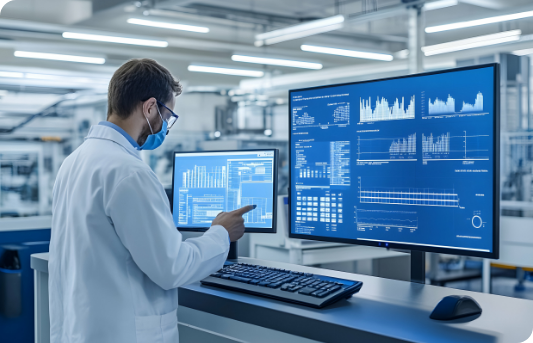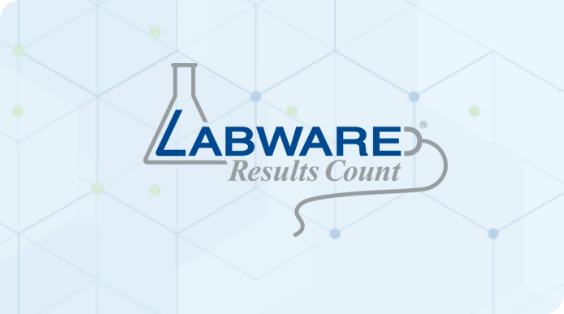Modern challenge: Data vulnerability in laboratories and LIMS Systems
After a 2023 data breach that impacted millions, Enzo Biochem had to pay a $4.5 million penalty and adopt new cybersecurity measures in August of last year. Investigation of the cyberattack revealed that Enzo was lacking proper file encryption, record maintenance, and monitoring practices to defend against breaches.
Meanwhile just last year, Summit Pathology Laboratories of Colorado also experienced a ransomware attack that exposed data of over 1.8 million patients. Sensitive information including names, addresses, insurance, Social Security numbers, and personal financials were compromised. As of November 2024, Summit is facing 8 proposed federal class action lawsuits.
Modern solution: Data automation for laboratories
To meet the demands of modern science, laboratories are turning to automation to streamline data management, reduce human error, and improve overall operational efficiency.
A 2025 survey of data teams shows that 90% of respondents have implemented or intend to implement data automation this year. Many share that they are beyond their limits in data workloads, identifying outdated legacy systems and broken data pipelines as contributing factors.

How can data automation help?
Let’s explore the best 8 practices for automating data management in laboratories to ensure seamless operations, accuracy, and scalability.
Assess current data management workflows
Before diving into automation, it is crucial to conduct a comprehensive assessment of the current data management workflows in your laboratory. This includes identifying bottlenecks, manual tasks prone to errors, and any inefficiencies in the existing processes.
As an example, chemistry workflows play an essential role in food and beverage testing. Here, the tasks involved are listed clearly - serving as a helpful template for an assessment.
Key Steps:
- Map out existing workflows.
- Identify areas for improvement.
- Prioritize tasks based on complexity and potential efficiency gains.
By understanding how data is currently collected, stored, processed, and shared, labs can pinpoint areas where automation can have the greatest impact. Common targets for automation include manual data entry, repetitive administrative tasks, and multi-step data processing workflows.
Implement a Laboratory Information Management System (LIMS)
One of the most effective ways to automate data management is by implementing a Laboratory Information Management System (LIMS). A well-designed LIMS centralizes all lab data, automates key processes like sample tracking, and provides real-time access to data across teams and locations.
Going into 2025, Research.com offers a comprehensive list of leading LIMS systems with contenders such as StarLIMS, LabWare LIMS, Bika LIMS, and Core LIMS by Thermo Fisher.
Customizable solutions such as LabWare LIMS allow laboratories to tailor the system to meet their specific needs, from data entry and analysis to reporting and compliance. To support your transition, LabWare provides a comprehensive guide here on effective workflow management using a LIMS.
Benefits of LIMS automation
- Automated sample tracking: Automatically record and track samples from submission to result reporting.
- Data centralization: Store all lab data in one accessible location, improving collaboration and reducing duplication.
- Regulatory compliance: Automate audit trails and ensure that all data is collected and stored according to industry regulations.
You can then implement web and cloud-based solutions for your LIMS as needed, such as those offered by Simplica for LabWare LIMS.
Leverage cloud-based data storage and access
Cloud-based solutions play a crucial role in automating data management by offering flexible, secure, and scalable storage. By storing data in the cloud, laboratories can ensure that their information is always available, accessible, and backed up, without the need for extensive in-house IT infrastructure.
Cloud-first automation is changing the game for laboratories attempting to enhance performance and maximize efficient workflows. For example, Simplica’s Managed Cloud Services for LabWare LIMS handles crucial components such as dedicated single-tenant environments and 24/7 monitoring and support - allowing you to focus on running lab operations.
Advantages of cloud automation
- Scalability: Easily expand storage as your data needs grow.
- Remote access: Enable lab personnel to access data from any location with internet access.
- Automated backups: Ensure continuous data protection with automated backup schedules.
Cloud-based storage also facilitates real-time collaboration across different lab locations, enabling teams to access the most current data and make informed decisions without delays.
Standardize data formats and processes
For automation to be successful, laboratories must standardize their data formats and processes. Inconsistent data collection methods can lead to errors, making it difficult to automate data aggregation or analysis.
Standardizing data entry fields, file formats, and reporting procedures ensures that the automation system can seamlessly process, store, and retrieve data. It also simplifies integration with other automated tools and third-party systems, enabling a more streamlined operation.
Key considerations
- Establish consistent naming conventions for samples, tests, and results.
- Use standard file formats (e.g., CSV, XML) for data exports and imports.
- Define clear workflows for data submission, validation, and approval.
- Access.
Electronic Health Information Exchanges (HIEs) frequently use two main kinds of health data standards: content and terminology. Content standards, such as HL7 v2, describe data structure while terminology standards outline health concepts.
Integrate systems for seamless data flow
Many laboratories rely on multiple systems for different aspects of their operations, such as instrument control, data analysis, and reporting. To automate data management effectively, it's important to integrate these systems, allowing for seamless data flow between them.
For example, integrating LIMS with cloud storage, data analysis platforms, and laboratory instruments can ensure that data captured by one system is automatically transferred to the others, eliminating the need for manual data transfer and reducing the risk of errors.
Integration Tips
- Use APIs (Application Programming Interfaces) to enable communication between systems.
- Automate data exchange between lab instruments and LIMS for real-time data updates.
- Ensure compatibility between systems by adopting industry-standard integration protocols.
Implement data validation and quality control
Automation is only as effective as the data it processes. To ensure accuracy, laboratories should implement automated data validation and quality control procedures. These tools automatically check for inconsistencies, missing information, or out-of-range results, flagging potential issues before they affect the final output.
Automating data validation not only improves accuracy but also speeds up the review process, enabling faster decision-making and reducing turnaround times.
Key practices
- Set up automated rules to check for data completeness and accuracy.
- Use quality control algorithms to detect outliers or anomalies in real-time.
- Automate alerts for missing or incorrect data entries.
Ensure data security and compliance
With the increasing importance of data integrity and privacy, automating data security is a critical component of effective data management. Laboratories must implement robust security measures to protect sensitive information and ensure compliance with regulatory requirements such as HIPAA or GDPR.
Automation tools can enforce data access controls, encryption, and audit trails to track every interaction with the data, ensuring that all activities are documented and secure..
Key Security Practices
- Use encryption to protect data both in transit and at rest.
- Automate access controls based on user roles and permissions.
- Implement automated audit logs to track data access and changes for compliance.
Provide user training and support
Automating data management requires that laboratory staff are fully equipped to use and maintain the new systems. Providing comprehensive user training ensures that everyone is comfortable with the automated processes and understands how to troubleshoot basic issues..
Regularly updating training and providing ongoing support ensures that the lab can maximize the benefits of automation without disruptions.
Training Tips
- Offer hands-on workshops or virtual training sessions on automated systems.
- Create easy-to-follow guides for common tasks and troubleshooting.
- Provide access to technical support for ongoing system maintenance and updates.
Conclusion
Automating data management in laboratories offers numerous advantages, from improving efficiency and accuracy to ensuring compliance and scalability. By following these best practices—starting with assessing workflows and implementing LIMS, to leveraging cloud storage and integrating systems—laboratories can optimize their operations and stay competitive in today’s data-driven world.
For LabWare LIMS users - Simplica’s custom web portals, managed cloud services, and integration expertise can help your laboratory unlock the full potential of data automation, driving better results, reducing costs, and ensuring that your lab remains at the forefront of innovation.
Recent Articles

The evolution of laboratory management: 20 years of Simplica and LabWare LIMS
Jan 7, 2025


